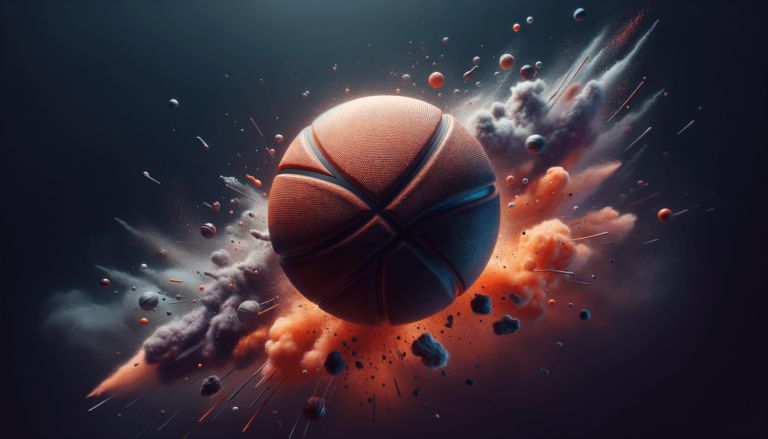
How Much Does an NBA Basketball Weigh?
Written by: Basketball Universe
Last updated:

As diehard basketball fans, we often get caught up in the excitement of high-flying dunks and buzzer-beating shots, but how often do we stop and ponder the fundamental object at the center of it all: the basketball itself? In this fun and informative deep dive, we’ll explore the specifics of an essential piece of equipment—the NBA basketball. You might be surprised by how much there is to know about its weight, the impact it has on gameplay, and the meticulous design decided upon by league officials. So grab your headset, squeeze your stress-ball, and let’s bounce into the fascinating world of NBA basketballs!
How Much Does an NBA Basketball Weigh?
An NBA basketball weighs approximately 22 ounces (1.4 pounds or 620-650 grams), with a circumference of 29.5 inches (75 cm), adhering to the league’s official guidelines and specifications.
Setting the Standard: Official NBA Basketball Specifications
Before delving into the weight of an NBA basketball, it’s essential to understand the league’s guidelines and specifications governing ball quality. Over time, the NBA has refined its basketball requirements for a consistently elite level of gameplay. Let’s take a look at these specifications and how they’ve been standardized across the league.
Size
The NBA has a specific basketball size, designated as “Size 7.” This means the ball has a circumference of 29.5 inches (75 cm). This size has been selected to provide optimum control and handling for the world’s best professional players who have larger hands than the average individual.
Material Composition
One key factor affecting a basketball’s weight is its material composition. The official NBA basketball is made of full-grain leather, which is both durable and strong. Originally, basketballs were constructed of stitched leather, but the introduction of the classic pebbled design we all recognize today drastically improved handling and control.
Manufacturer
The NBA partners with specific manufacturers to ensure that their basketballs meet the league’s exacting quality standards. For many years, Spalding was the league’s exclusive basketball manufacturer. However, in 2020, the NBA switched to Wilson, which now produces the official NBA basketball.
Weighing in on the NBA Basketball: Factors and Impact
Now that you have a solid grasp of official NBA basketball specifications, let’s turn our attention to understanding how the weight of the basketball impacts the game.
Weight Range: Precision Matters
The weight of an NBA basketball can vary slightly between 22 ounces (1.4 pounds or approximately 620 grams) and 23 ounces (about 650 grams). This precision matters, as a heavier or lighter ball can dramatically influence players’ control, shooting, and handling. The perfect range for an NBA basketball ensures that the ball is not too heavy to manipulate or too light to provide stability during decisive moments in the game. Additionally, maintaining the weight range across all 30 NBA teams guarantees a level playing field for players.
Impact on Shooting Performance
Basketball players have honed their shooting form and muscle memory to adapt to the standardized basketball weight. The detailed mechanics of a player’s shot, from the lift-off and release to the arc of the ball, are all affected by the ball’s weight. A fraction of an ounce could potentially disturb a player’s shooting abilities—the result of years of practice.
Dribbling and Passing
A player’s dribbling and passing skills also benefit from a consistent basketball weight. When handling the ball, the player’s hand strength and dexterity are important factors, and a consistent weight allows them to showcase their skills without hinderance. The NBA’s standardized weight level enables pinpoint passes and smooth dribbling moves without unnecessary alterations to player’s style.
Rebounding and Ball Control
In basketball, controlling the boards is crucial to victory. A well-weighed basketball ensures predictable ball trajectory when rebounding off the rim or the backboard. This predictability leads to improved shot accuracy, while also enabling players to position themselves for successful rebounds, ultimately creating more efficient transitions and offensive opportunities.
The Science and Fine-Tuning of the NBA Basketball
As all great sports organizations do, the NBA dedicates itself to using science and engineering to create the highest quality equipment. This dedication drives innovations in the design and manufacture of the NBA basketball, including fine-tuning critical factors like weight, shape, and dimensions.
Engineering a Perfect Sphere
Basketball researchers and manufacturers closely collaborate to create the most accurate sphere possible. A perfectly geometric sphere reduces wobble during flight, ensuring that players can rely on their shooting and passing techniques. Also, the shape directly influences the ball’s weight distribution, giving the ball a consistent balance during gameplay.
Weight Distribution and Internal Pressure
A factor often overlooked when considering basketball weight is its internal pressure. The regulation pressure for an NBA basketball is between 7.5 and 8.5 PSI (pounds per square inch). Manufactures use synthetic bladder and valve technology to maintain the ideal internal pressure. Having a consistent pressure throughout the ball ensures proper weight distribution and ball handling characteristics.
Material Density and Design Impact
Did you know that the density and design of the basketball’s material can impact its weight? The NBA has established precise specifications for the materials used in constructing its basketballs. The official ball features a full-grain leather shell and uses high-quality rubber and synthetic materials in its inner layers. This combination ensures not only the correct weight but also reliable structural integrity and durability for long-lasting performance at the highest level of professional play.
Beyond the NBA: Basketball Weights and Sizes for Other Leagues
While we’ve focused primarily on the NBA basketball, it’s worth noting that basketball weights and sizes differ across other leagues. These variations cater to the specific needs of players at different levels of skill and physical development. Let’s explore the typical basketball weights and sizes found in these other leagues.
WNBA Basketball
The Women’s National Basketball Association (WNBA) uses a slightly smaller ball known as a “Size 6” basketball, which has a circumference of 28.5 inches (72 cm). The primary reason for this difference is the consideration of the average hand size of female players, ensuring that they can also achieve optimal control and handling. The weight of a WNBA basketball is approximately 20 ounces (1.25 pounds or 567 grams).
FIBA Basketball
The International Basketball Federation (FIBA) governs many international basketball competitions outside of the NBA, including the Olympic tournaments. FIBA has adopted the same basketball size as the NBA (Size 7), with a 29.5-inch circumference. However, FIBA’s weight requirements are slightly lower than the NBA’s, falling within the range of 20 to 22 ounces (approximately 567 to 620 grams).
Youth Basketball
Youth basketball leagues often implement smaller balls to accommodate children’s smaller hands and physical capabilities. For players ages 12 and under, a “Size 5” basketball with a 27.5-inch (70 cm) circumference is commonly used. This size weighs around 17 ounces (1.06 pounds or 482 grams), once again considering the needs of younger, developing players.
The Basketball: An Unassuming Star on Court
As diehard basketball fans, we often focus on the exhilarating plays, phenomenal athletes, and fierce rivalries that make this sport so thrilling. This exploration into the intricacies of NBA basketballs highlights the often unappreciated importance of the equipment upon which the entire game is built. So, the next time you witness an awe-inspiring dunk or a seemingly impossible shot, take a moment to appreciate the unassuming star on the court—the meticulously crafted NBA basketball.
Maintaining Consistency: Care, Storage, and Replacement of NBA Basketballs
One may wonder how the NBA ensures its basketballs maintain the ideal weight and performance during use. An integral part of the process includes taking care of the ball, storing it properly, and knowing when it requires replacement. In this section, we’ll explore the methods employed to guarantee balls remain in peak condition throughout the season.
Proper Cleaning and Care
Keeping NBA basketballs clean and well-maintained is crucial to preserve the ball’s ideal weight and characteristics. It’s important to frequently wipe away dirt, dust, and sweat from the surface of the ball—debris that may affect the grip and performance. For the best results, manufacturers often recommend using a damp cloth with a mild soap solution to clean the leather, followed by a dry cloth to remove excess moisture. Properly caring for the ball can prolong its life and ensure a consistent weight and performance over time.
Optimal Storage Conditions
Another aspect of preserving the basketball’s weight and performance is maintaining optimal storage conditions. Extreme temperatures and direct sunlight can damage the ball, altering its shape and internal pressure. Storing basketballs in a cool, dry environment away from direct sunlight can help them maintain their ideal pressure and structural integrity, ensuring consistency and reliability for the athletes on the court.
Monitoring and Replacement
Despite consistent care and storage, basketballs do wear out and require replacement. NBA teams must constantly monitor their stock of basketballs and replace them as needed, following league guidelines. Providing fresh basketballs helps maintain the desired weight range and ensures optimum performance during games. Additionally, ensuring that all teams use similar-quality balls cultivates a fair competition and guarantees a level playing field for all players.
Basketball: A Universal Sport with a Specific Science
As we’ve explored in this comprehensive look at the NBA basketball, weight is just one vital aspect of the ball’s detailed specifications. With an unwavering commitment to consistency and superior performance, the NBA’s rules and regulations guiding ball design, material, and care contribute to the incredible gameplay displayed in each high-stakes matchup.
From the early days of simple stitched leather balls to today’s scientific approach that includes precise specifications and innovative materials, basketball equipment has evolved to ensure the highest level of play possible. Ultimately, both the NBA and basketball enthusiasts worldwide benefit from this dedicated pursuit of excellence in the game. Without a doubt, the attention to detail poured into every single NBA basketball underscores the undeniable passion and love we all share for the sport.
FAQ Section: All About NBA Basketball Weight and More
Being well-informed about NBA basketball weight and related topics can enhance your appreciation for the sport. Here are some frequently asked questions regarding basketball specifications and usage, complete with straightforward, NLP-style answers.
1. What is the weight of NBA basketballs?
NBA basketballs weigh between 22 to 23 ounces (1.4 pounds or approximately 620 to 650 grams).
2. What material is used for official NBA basketballs?
NBA basketballs are made of full-grain leather, which provides high durability and strength.
3. Are there different sizes of basketballs?
Yes, basketballs come in various sizes such as Size 5 (27.5-inch circumference), Size 6 (28.5-inch circumference), and Size 7 (29.5-inch circumference) for youth, women’s, and men’s leagues, respectively.
4. What is the WNBA basketball size and weight?
The WNBA uses a Size 6 basketball with a circumference of 28.5 inches (72 cm) and a weight of approximately 20 ounces (1.25 pounds or 567 grams).
5. What is the FIBA basketball size and weight?
FIBA uses a Size 7 basketball, just like the NBA, with a 29.5-inch circumference. However, the weight is slightly lower, ranging between 20 to 22 ounces (approximately 567 to 620 grams).
6. Can the pressure of a basketball affect its weight?
Yes, variations in a basketball’s internal pressure can affect weight distribution and handling characteristics. The regulation pressure for an NBA basketball is 7.5 to 8.5 PSI.
7. Do NCAA basketballs have different specifications?
NCAA basketballs are similar to those used in the NBA, with the men’s balls having a circumference of 29.5 inches but with a slightly softer leather cover. Women’s NCAA basketballs have a circumference of 28.5 inches.
8. What size basketball is used in youth leagues?
Youth basketball leagues often use Size 5 basketballs with a circumference of 27.5 inches (70 cm) and a weight of around 17 ounces (1.06 pounds or 482 grams).
9. Why do basketballs have a pebbled texture?
The pebbled texture improves grip and handling, providing players with better control over the ball.
10. Do NBA teams have special balls for practice?
Yes, NBA teams often have designated practice balls, which are the same size and weight as those used in games but may exhibit more wear or feature practice markings.
11. How often should an NBA basketball be replaced?
Replacement frequency varies; however, NBA teams must constantly monitor their stock and replace balls when signs of wear or degradation appear, ensuring optimal performance during games.
12. Is there any difference between indoor and outdoor basketballs?
Yes, outdoor basketballs are typically designed with a tougher exterior made of rubber or synthetic materials, which helps them withstand rough surfaces and outdoor conditions.
13. Can I clean an NBA basketball? If so, how?
Yes, you can clean an NBA basketball by wiping the surface with a damp cloth and a mild soap solution. After cleaning, use a dry cloth to remove any excess moisture.
Featured Posts
- No pillar pages found.





